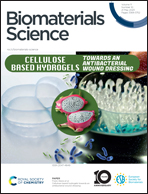ROS-scavenging nanomedicine for “multiple crosstalk” modulation in non-alcoholic fatty liver disease†
Abstract
Non-alcoholic fatty liver disease (NAFLD) is a chronic inflammatory disease characterized by “multiple crosstalk” paths of insulin resistance, lipid metabolism, oxidative stress, etc. The combination of LY294002 and oridonin was proposed as a promising therapy by targeting insulin–PI3K/AKT signaling and NF-κB inflammatory pathway. However, due to oxidative stress, disease-associated upregulation of murine CYP3A11 activity can contribute to unexpected drug metabolism and disposition, which could seriously hinder the efficacy of LY294002 and oridonin. Nanotechnology-based effective reactive oxygen species (ROS) scavengers have emerged as a promising strategy to overcome these limitations. In this study, a rationally designed ROS-responsive liposome loaded with oridonin and LY294002 (RLLs) was developed for effective liver deposition and metabolic regulation for NAFLD treatment. First, we ascertained that the insulin resistance-induced signaling response was balanced by the combination of LY294002 and oridonin. Then, the particle size, zeta potential, ROS-responsive release behavior, and ROS-scavenging properties were investigated. Moreover, the CCl4-exposed mouse model was used to assess the biodistribution and therapeutic efficacy of RLLs on NAFLD. Finally, the “multiple crosstalk” modulation of RLLs was explored by western blotting, enzyme-linked immunosorbent assay, and polymerase chain reaction analysis. RLLs exhibited antioxidant efficacy for the safe delivery of LY294002 and oridonin with good stability and biocompatibility. The biodistribution analysis proved that the accumulation of RLLs was significantly increased due to CD44-mediated targeting. In addition, RLLs had comprehensive protective effects on the CCl4-exposed mouse model, leading to significant elimination of excessive ROS, maintenance of insulin sensitivity and CYP450 activity, and reduction of inflammatory response. In the CCl4-induced mice, RLL intervention remarkably improved metabolic profiles and reduced the fibrosis lesions. Our results provided a strategy for the amelioration of oxidative stress and CYP450 activity using ROS-responsive thioketal as an antioxidant adjuvant facilitated by nanotechnology.



 Please wait while we load your content...
Please wait while we load your content...